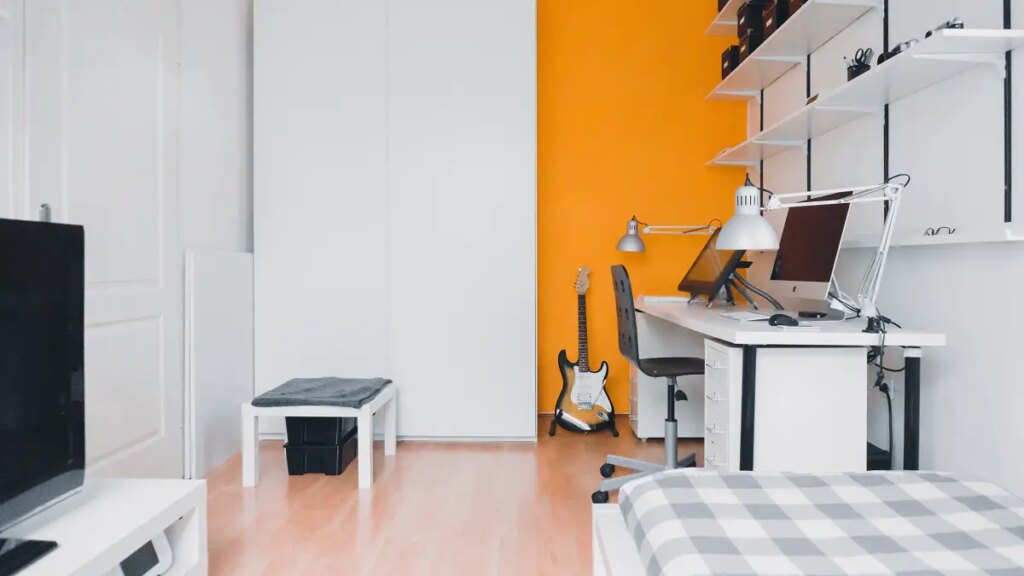How To Create a Minimalist Home: Here Are 16 Tips To Get You Started

In today’s article you’ll learn everything you need to know about how to make a minimalist home. So, let’s get started!
How to Make a Minimalist House:
1. Change one room at a time.
Unless you are just moving someplace, it is difficult to outline your entire home without a moment’s delay. Concentrate on one room, and let it be the point of interest of your serenity. Use it to wake you up to upgrade the next room, and the next. Then do the same outside!
2. Start with the furniture.
The smartest thing in any room is the furniture, so it is all the time best to start improving a room by looking at the furniture. The fewer home items, the better (sensibly, obviously). Consider which furniture can be removed without compromising comfort and sturdiness. Choose some plain, easy pieces of furniture (here, a small footstool box) in bold, restrained colours.
3. Keep the basics only.
In terms of looking at your furniture or anything in the room, ask if that item is actually that important. If you can live without it, get it out. Try to strip the room all the way down to the basics — you can generally incorporate some decisions beyond the basics later. Keep the whole structure (house) on paper as easy as possible at first, with the mandatory parts, and then add style gradually as needed.
4. Clean the ground.
Except for furniture, your floor must be perfectly clean. Nothing is allowed to litter the ground, nothing is allowed to be piled up, nothing is allowed to be removed on the ground. Once you have your furniture to a minimum, clean everything else on the ground — give it away, throw it away, or find a place for it away.
5. Clean the surface.
The same with every level surface. Try not to wear anything on them except some basic decorations. Give it away, throw it away, or find a space far away for others. This will make things look a lot less trivial.
6. Remove dividers.
Some people balance things on their walls. Nothing to do at home is moderate. Clear your borders apart from a few basic pieces of decent art.
7. Keep things away.
This has been mentioned in the tips above, but you should keep everything you need far away, in drawers and cabinets. Bookcases can be used to store books or DVDs or CDs, but they should not have much else than a few basic decorations (not a full set of things).
8. Eliminate clutter.
If you clean flat surfaces and floors, and store things in cabinets and drawers, you’ll probably need to liberate your storage place as well. You can do this at a later stage if you need.
9. Utilizing basic fine arts.
To keep the room from getting boring, you can put a basic painting, picture or photo, surrounded by a muted, strong color, on each wall if you like. Ignore some exposed delimiters if possible.
10. Take advantage of base upgrades.
As referenced in the tips above, some basic enrichments can serve as accents for a medium room. Flower vases or small, trimmed plants are two exemplary precedents. If the rest of your room is limited in color, your articulation can use a bright color, (for example, red or yellow) to draw attention and provide a plain room a splash of energy.
11. Leaning on regular window remedies.
Windows that open, or strong, sturdy curtains, or basic wood blinds are great. Too many fancy items around the windows make a mess.
12. Accept easy examples.
Solid colours work best for floor coverings (if you have any), furniture, etc. Complex examples, such as flowers or checkers, are visual clutter.
13. Make use of restrained colours.
You can have a splash of bright color in the room, but most rooms should be of a more muted tone — white is a moderate color, but any strong color that does not strain the eye is okay (earth tones ring the bells, for example, blue, brown, tan, or green).
14. Convert and discard.
Once you have outlined a room, you may have the ability to accomplish so much more. Give it a few days and then look at things with an open perspective. What can be destroyed? keep? What’s not basic? You can return through each room like clockwork, and from time to time you will come across things that you can untangle further.
15. Have a place for everything.
In a modest home, it is vital that you find a place for everything. Where did your blender go? Choose a consistent spot that’s near where the item is used, to make the item more efficient, but the key is to set a spot and stick with it.
16. Sit back, relax, and appreciate.
When you have outlined a room, investigate and appreciate it. It is very serene and satisfying. This is a reward for your hard work.
I want to thank you for taking the time to read my article on how to make a minimalist home. I actually hope that its content has been of good help to you.







